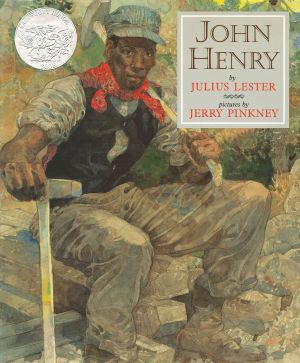John Henry by Julius Lester
Julius Lester was an American writer of books for children and adults. He was an academic who taught for 32 years (1971–2003) at the University of Massachusetts Amherst. He was also a photographer, as well as a musician who recorded two albums of folk music and original songs.[1]
Summary
This amazing book talks about a great American hero comes fully to life in this epic retelling filled with glorious, detailed watercolors. From his momentous birth, when all the animals come to see him and the sun won't go to bed, John Henry works wonders. As a child he helps his father by adding "a wing onto the house with an indoor swimming pool and one of them jacutzis-and that's just before lunch. Other episodes trace the growth of his generous spirit. His greatest feat is, of course, in his battle against the steam drill, as he races the machine to cut through", a mountain as big as hurt feelings.[2]
Pros
Abigai who rated this book four stars spoke out her thought about this book, the author Julius Lester and illustrator Jerry Pinkney join forces in this lovely picture-book retelling of the tall tale of John Henry, the legendary African-American steel driver whose contest with a steam-powered drilling machine has been immortalized in American folk music. Extraordinary from the moment he was born, John Henry amazed the woodland animals, his parents, and the sun and moon themselves. Eventually setting out to make his way in the world, he performed marvelous feats, before eventually coming to the mountain in West Virginia where the railroad needed to get through. Paul Dilley as the other readers also described about this book, he said that his son really enjoys this book, and so do Him, especially for its take on African-American folklore from the South, about which is unfamiliar for him. For some reason he was fascinated by the villain “Ferret-faced Freddy” (maybe all those stories about the pet ferret from my childhood?). The drawings are wonderful. And the story is very life-affirming, even though the protagonist faces many challenges and only lives for a few days.[3]
Kirkus posted their reviewd of this book, they wrote that Pinkney's watercolors walk a smart and lovely line between ephemerality and sheer natural energy. The rainbow whispers the lesson here: "Dying ain't important. Everybody does that. What matters is how well you do your living."[4]
School Library Journal review that this book was told with just a trace of dialect, the story moves along briskly toward the climax. Its moral message of the importance of a well-lived life is clearly stated, and the ending is uplifting. Pinkney's marvelous watercolors, abundantly rich in detail, convey both the superior strength and the warm sense of humanity that make John Henry perhaps a more down-to-earth character than some other tall-tale figures. The paintings' muted earth tones add a realistic touch to the text, bringing this John Henry alive. When viewed from a distance, however, figures and details sometimes blend together, making the book better suited to independent reading that group sharing. It will appeal to an older audience than Ezra Jack Keats's John Henry (Knopf, 1987) and is a fine addition to any folklore collection. [5]
References
- ↑ Julius Lester. goodreads.com. Retrieved January 31st, 2021.
- ↑ John Henry. publishersweekly.com. Retrieved January 31st, 2021.
- ↑ John Henry. goodreads.com. Retrieved January 31st, 2021.
- ↑ John Henry. kirkusreviews.com. January 31st, 2021.
- ↑ Keefer, Lisa. JOHN HENRY by Julius Lester. January 31st, 2021.

